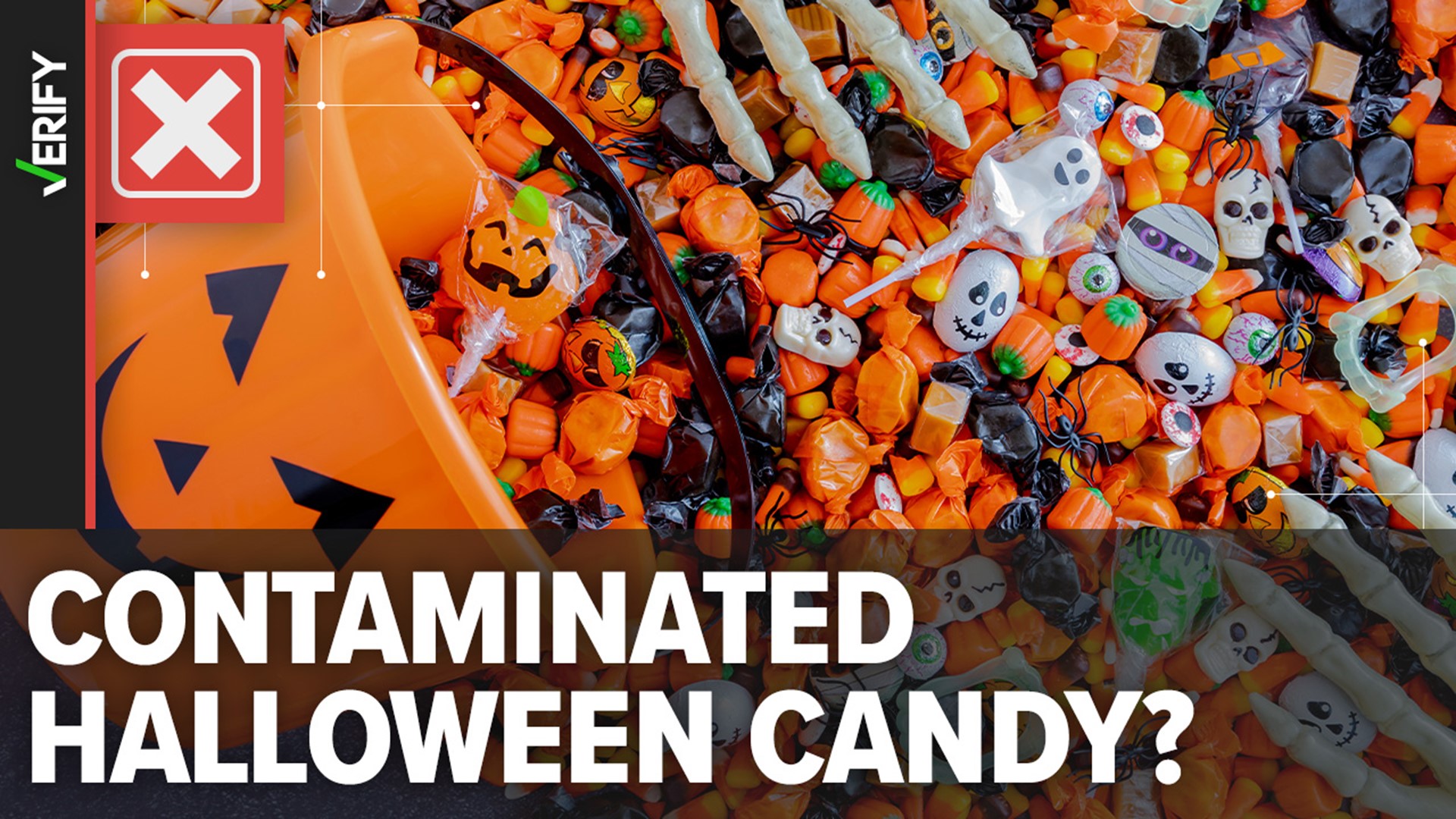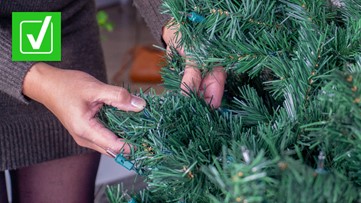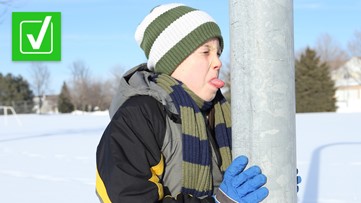In the weeks leading up to the spookiest day of the year, local news reporters, police departments and lawmakers often warn parents about the possibility of people tampering with their kids’ Halloween candy.
This has left many parents worrying about what could potentially end up in their child’s trick-or-treat bag.
VERIFY viewer Angela asked our team on Facebook if there is any truth to these claims.
THE QUESTION
Are legitimate reports of contaminated Halloween candy common?
THE SOURCES
- Drug Enforcement Administration (DEA)
- National Institute on Drug Abuse (NIDA)
- Joel Best, Ph.D., professor of sociology and criminal justice at the University of Delaware
- Nabarun Dasgupta, MPH, Ph.D., Senior Scientist, Injury Prevention Research Center Innovation Fellow at the UNC Gillings School of Global Public Health
- Ryan Marino, M.D., medical toxicologist, emergency physician and addiction medicine specialist at University Hospitals Cleveland Medical Center
- Lt. Ryan Bessette, public information officer at the Waterbury Police Department
- Wayne Bird, police chief of the Williamsburg Police Department
- Frederick Harran, director of public safety at the Bensalem Police Department
- Chris Gaddis, assistant chief of police at the Burlington Police Department
- Jon Reed, chief of police at the Winchester Police Department
- Gloucester Township Police Department
THE ANSWER
No, legitimate reports of contaminated Halloween candy are not common.
WHAT WE FOUND
Joel Best, a sociology and criminal justice professor at the University of Delaware, says the theory of giving contaminated treats to children during trick-or-treating was first referred to as “Halloween sadism” in the 1970s.
“Halloween sadism is the idea that there are maniacs who try to harm children by passing out contaminated treats — razor blades in apples, pins in candy bars, poisons in treats, and so on,” Best told VERIFY.
In 1985, he co-authored an article that reviewed the press coverage of Halloween sadism from 1958 to 1984 in four U.S. newspapers: The New York Times, the Los Angeles Times, the Chicago Tribune, and the Fresno Bee. He later published a book that featured an updated version of the article in 1990.
Best says he has not found one incident of a child being injured or killed from contaminated candy after trick-or-treating on Halloween since he first began compiling his data.
“I've been studying this for a long time and I can't find any evidence that any child has ever been killed or seriously hurt by a contaminated treat picked up in the course of trick-or-treating. I think that this is best understood as a contemporary legend,” Best said.
Contemporary legends, also referred to as urban legends or urban myths, are stories that are told as true, even though there may be little or no evidence that the events in the stories have ever occurred, and are often ways people express anxiety, according to Best.
He says concerns about Halloween sadism tend to be particularly acute in years when some sort of terrible recent crime has heightened public fears. In 2022, Best called “rainbow fentanyl” the newest Halloween scare in an article published in The Conversation.
“What seems new about describing rainbow fentanyl as a Halloween danger is the willingness of important political figures and news media outlets to spread the warnings. Most past claims about Halloween sadism lack such prominent spokespeople,” Best wrote.
DEA Administrator Anne Milgram also addressed the rainbow fentanyl claims in interviews with NBC and Fox News in 2022, and said she does not believe that children are at risk of coming in contact with “rainbow fentanyl” on Halloween.
“At this moment ... we’ve seen nothing that indicates that this is going to be related to Halloween or that drug traffickers are putting it into Halloween candy. If we ever had that information, I would put it out right away because I want everyone to know what we know,” Millgram said.
Instead, the National Institute on Drug Abuse (NIDA) says researchers in recent years have seen “a dramatic rise” in overdose deaths among adolescents aged 14-18 “that is likely being driven by illicit counterfeit pills containing fentanyl.”
“It is extremely important to inform young people, parents, schools, and communities that prescription pills purchased on social media, given to someone by a friend, or obtained from an unknown source are extremely dangerous and may contain deadly fentanyl,” NIDA told VERIFY.
Nabarun Dasgupta, a researcher studying illegal drugs at the University of North Carolina, and Ryan Marino, a medical toxicologist and addiction medicine specialist at University Hospitals Cleveland Medical Center, both told VERIFY parents should not be concerned about “rainbow fentanyl,” or other drugs popping up in their child’s Halloween basket.
“There is no evidence that drugs are being made to target children, and the idea that anybody would give away free drugs to trick-or-treaters has been repeatedly debunked,” Marino said.
“The more direct threat to children during trick-or-treating is being hit by a car in the dark. So parents should spend more time making sure costumes have headlight reflective elements, not worrying about fentanyl in candy,” Dasgupta said.
The VERIFY Team also reached out to several police departments across the country that had previously received reports of potentially contaminated Halloween candy over the last decade.
In September 2021, the Bensalem Police Department in Pennsylvania confiscated 50 marijuana-laced edibles that mimicked popular snack brands. Frederick Harran, director of public safety for the Bensalem Police Department, told VERIFY the incident was not connected to Halloween. He also said the police department hadn’t received any reports of contaminated candy being given to children in the past.
On Nov. 1, 2019, a 37-year-old man in Waterbury, Conn., was arrested after parents found razor blades at the bottom of their kids’ trick-or-treat bags. The children were not injured or hurt, but police say Jason Racz was charged with risk of injury to a minor, reckless endangerment and interfering with a police officer.
“We are not aware of any incidents prior or since that incident occurred,” Lt. Ryan Bessette, a public information officer at the Waterbury Police Department, told VERIFY. “Historically, we have not had issues with any contaminated Halloween candy.”
Meanwhile, in another Nov. 2019 incident, the Burlington Police Department in Burlington, N.C. shared on its Facebook page that it had been made aware of a social media post stating that a family member believed a child had been exposed to contaminated candy they acquired on Halloween.
“We became aware when a relative began using social media platforms to post unconfirmed assumptions of the cause of the child’s temporary illness. We made the post to help slow down inaccurate information that was being shared and to help bring clarity to the situation for our community,” Assistant police chief Chris Gaddis told VERIFY.
“We reached out to the family and local health groups to investigate. We never confirmed that a crime or exposure to contaminated Halloween candy occurred. The family wished not to pursue any additional assistance,” Gaddis said.
Gaddis says the department did not receive any reports of similar incidents in October or November 2019 and says they haven’t received any since then.
In Whitley County, Ky., a local news station reported in Nov. 2019 that police were warning parents about contaminated Halloween candy after CBD gummies were allegedly passed out to kids who were trick-or-treating. Police Chief Wayne Bird confirmed with VERIFY that the incident was isolated and no arrests were made. He says the department has not had any further reports of similar incidents in the area.
In Nov. 2015, police in Winchester, Indiana, shared on their Facebook page that they had received reports of people placing razor blades in candy bars on Halloween. Chief Jon Reed of the Winchester Police Department told VERIFY that report was determined to be a hoax. He says the department has not received any similar reports since then.
The Gloucester Township Police Department responded to a home in Blackwood, N.J., after a man reported he had found four sewing needles in four separate pieces of candy from trick-or-treating on Halloween in Nov. 2015. After an investigation, police say it was discovered that the man had made up the story and had placed the needles in the candy bars himself. He was arrested and charged with making a false police report.
If you’re worried about the candy your kids get on Halloween, Dasgupta recommends making sure kids avoid eating unwrapped candy they may receive while trick-or-treating. The Food and Drug Administration (FDA), which shares a list of Halloween food safety tips on its website, also says to “tell children not to accept – and especially not to eat – anything that isn’t commercially wrapped.”
“Inspect commercially wrapped treats for signs of tampering, such as an unusual appearance or discoloration, tiny pinholes, or tears in wrappers. Throw away anything that looks suspicious,” the FDA writes.












